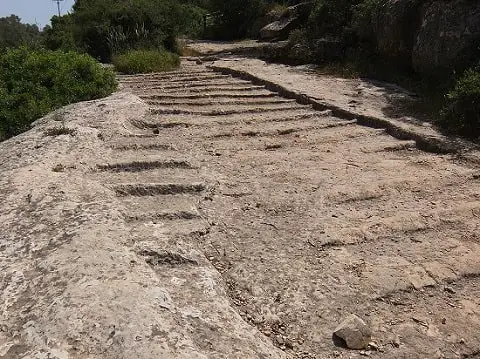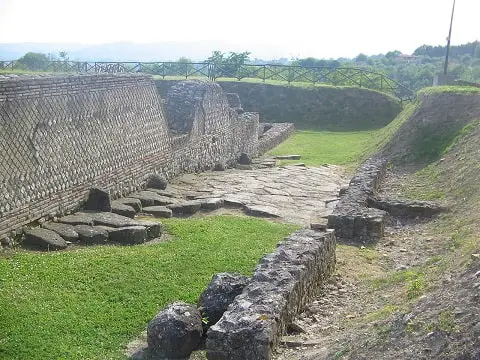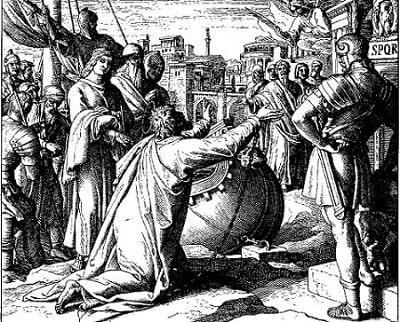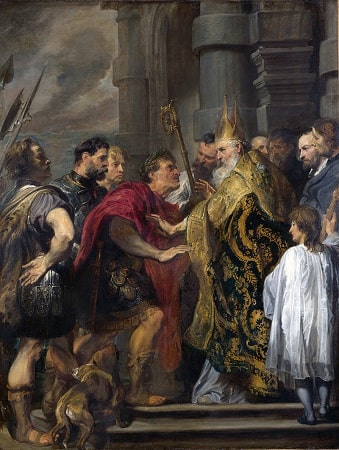Roman roads were constructed between 300 BC and 300 AD when the Roman Republic and Empire expanded and consolidated. They were one of the most essential Roman inventions that helped Roman development.
They allowed for the effective land movement of authorities, individuals, armies, and interior transportation of official messages and commercial items.
The tiny town roads were used to expand highways linking all military posts, cities, towns, and marketplaces.
Footpaths, bridleways, and drainage ditches flanked these significant roadways, which were usually paved with stone and metal with some places curved upward for a smooth drainage system.
They were put out on carefully measured routes, with some cutting through hills and crossing over rivers.
At the height of Rome’s expansion, 29 extensive military routes emanated out from Rome’s capital, while 372 great roads connected the late Empire’s 113 provinces.
There were about 400,000 km of road, including about 80,500 km of stone-paved highways.
The ancient Mediterranean world’s system of Roman roads was an excellent transportation network.
It stretched up to the Tigris-Euphrates, starting from the British Isles and up to the Northern part of Africa and Spain from the Danube.
For the primary purpose of military service, the Romans constructed 80,000 kilometers of highway with a very hard and strong surface.
Censor Appius Caecus built the first Roman highway in 312 BCE and named it the Via Appia, meaning the Appian Way.
It was initially 261 kilometers long, running southeast towards Tarentum, which ended up being lengthened up to the Adriatic coast located at Brundisium.
Laws related to Ancient Roman Roads
Content

The Roman Law, famously titled the laws of 12 tables, originating from around 450 BC, stipulated that public roads needed to be about eight Roman feet broad in straight sections and double that width in curved sections. These were most likely the bare minimums.
However, during the Roman Republic, public roadways in rural areas had roughly 12 Roman feet, allowing 4-foot wide carts ( only two ) to pass without interfering with pedestrian traffic. Actual practices differed from the norm.
The Tables ordered that public roads be built and that wayfarers were given permission to use the privately owned lands if the route was poor.
The primary and ideological goal was to build proper straight roads that could last longer, produce the shortest roadways, and conserve goods/materials.
The law also included that the roads could be used as a liability while prohibiting cars in towns or cities, considering some limited circumstances.
As per the Municipal of Lex Iulia, commercial carts were only allowed to enter the city at night that too within a few kilometers of the city walls. At the same time, government officials traveled for business purposes, and married women were able to ride.
Types of Roads
Ancient Rome had a variety of roads, from very simple graveled to properly stone-paved roads. The paved roads would mostly use tamped rubble underneath to make the roads dry during the rainy season or when the water ran down between the stones.
Ancient Rome, however, had three major types of roads:
- Viae publicae
- Viae privatae
- Viae vincinales
1. Viae publicae

The earliest road was the major highway, also known as the public highway. These roads were owned by the state but were built under the maintenance of the expenses collected from the public.
These routes would lead to various places, including public rivers, sea, town, or sometimes to another public highway.
Romans described these roads in various ways. For instance:
- The roads were placed under commissioners, which were repaired and reconstructed by the contractors using the amount collected from the public. The landowners, however, would have to pay a predetermined amount.
- The roads of Ancient Rome were named based on the person responsible for building them. For example, Cassia and Flaminia are the names of the censor responsible for the construction or reparation of the Roman roads.
However, even though the same person frequently served as consul subsequently, the name of the road would date only to the time of that person’s censor.
But, if such roads were built before the censorship office or had no known origin, the roads were given the names of the final destination or sometimes the region that was used mostly during the travel.
2. Viae privatae

The land owners built private roads or country roads and were given the authority to dedicate those roads to the public.
Viae privatae included roadways leading from public highways to specific estates or communities.
In North Africa, primary and minor roads might be paved or unpaved and covered in gravel.
3. Viae vincinales

Roads leading through or towards a vicus or village fell were known as the Viae vicinales. This category included district roads, village roads, and even crossroads.
These roads would generally pass or run into highways or other vicinities but would never connect to them directly.
Additionally, these roads were classified as private and public, depending on the finance, expense, and resource used during the construction process. For instance, if the road were built with private expenses, they would fall under private roads.
Interestingly, the private roads would be converted into a public roads after the death of the constructor.
Roads and Christianity in Ancient Rome

The Roman road system enabled Roman conquest and administration and provided roadways for the Empire’s vast migrations and a conduit for the spread of Christianity.
Despite the neglect, it served Europe throughout the Middle Ages, and many remnants of the system can still be found today.
The highways aided in the rapid spread of Christianity. Missionaries would travel and disseminate along these highways to proselytize the new religion.
It was an effective mode of communication since it was simple to travel to a significant settlement on a single road rather than navigating barriers (such as hills).
The famous Roman Roads of the Ancient Empire were essential technological improvements that aided the fast spread of Christianity.
Their construction was intentionally planned to coincide with the Incarnation of Christ and the Apostle Paul’s subsequent missionary trips.
These continent-connecting arteries began around 500 B.C. and covered more than 250,000 km. They helped the Roman Empire expand, but they also helped the Gospel spread.
Similarly, the new roads are having an impact.
According to some Christians, churches, and Bible agencies, someone else has already paid for these new roads. These technological pathways are open and ready for a million faith and witness trips.
The team is a bunch of techno-evangelists who have captured one and have already made significant progress.
The advancement of Christianity throughout the Roman Empire

Although Jesus only preached for three years of his life, his message has impacted our modern world.
Jesus had twelve disciples who helped him spread his teachings. One of the reasons for his message’s popularity was that he talked in plain English that everybody could comprehend.
At first, only Jews were instructed about Jesus’ message. Paul (Saul) of Tarsus, who lived in the first century A.D., spread the Christian word to non-Jews.
Paul traveled throughout the Roman Empire’s eastern provinces. Paul addressed the Galatians, a group of Celts from Asia Minor.
The impoverished and women were drawn to Jesus’ message of equality. The majority of new Christian converts came from these two groups.
By the mid-first century, Rome may have had as many as one million residents, serving as a growing center of commerce and government with far-reaching influence.
Early Christian leaders like Peter and Paul ministered there, and the city may have had as many as one million residents by the mid-first century.
Rome became the epicenter of this rising religion throughout the first decades of the early Church, as the message of Jesus Christ spread beyond Jerusalem and took root among Gentile visitors and merchants.
In this tumultuous environment, the early Church thrived. Despite the polytheistic, pagan world surrounding them, early believers gathered together in secret chambers and private homes to worship the true God.
The city was home to thousands of these disciples. Many citizens were receptive to the Gospel message, and their love for Jesus triumphed over their allegiance to the Empire.
Pagan leaders, such as Nero, were enraged by this and began persecuting and executing Christians who fled, taking advantage of the safe passage given by Roman highways to get out quickly and efficiently.
The Pax Romana and Roman roads aided in the spread of Christianity. Many Romans were concerned about the advent of Christianity since Christian teachings clashed with traditional Roman practices.
In A.D. 64, Nero, the Roman Emperor, initiated one of the first persecutions of early Christians. In A.D. 64, the Great Fire of Rome engulfed the city, destroying most of it.
Despite persecutions, Christianity grew in popularity across the Roman Empire.
The Reign of Constantine I

Constantine governed Ancient Rome from 313 to 337 AD. He relocated the Empire’s capital to Byzantium in the east. In the middle of the Empire, Rome had become a lesser-known city.
Byzantium was situated on vital trade routes in the Empire’s wealthier East. In honor of Emperor Constantine, the city was later renamed Constantinople.
Christians were no longer persecuted under Constantine, which was a significant shift. They were allowed to practice their religion openly.
Later, Emperor Theodosius (ruled 379-395) proclaimed Christianity the Roman Empire’s official religion. Not surprisingly, Theodosius also stopped the ancient Olympic Games, held to honor the God Zeus.
Theodosius was the last emperor to reign in the whole Roman Empire, as it split once more following his reign, with one emperor ruling the East and the other ruling the West.
Conclusion
Straightness, sturdy foundations, cambered surfaces to aid drainage, and concrete constructed from pozzolana (volcanic ash) and lime were all features of the Roman roads.
The Roman engineers used essentially the same ideas in building abroad as in Italy, though they adapted their technique to materials accessible locally.
The Roman armies were in charge of constructing roads of 2.4 meters. Later, the local government provided funding for road construction projects.
There were 400,000 kilometers of roadways, with 80,500 kilometers of paved roads.
The viae was the name given to roads in the Roman Empire. Because of their quality, roads were often referred to as “walls built on their sides because of their quality.”
The highways aided in the rapid spread of Christianity. Missionaries would travel and disseminate along these highways to proselytize the new religion.
It was an effective mode of communication since it was simple to travel to a significant settlement on a single road rather than navigating barriers (such as hills).
